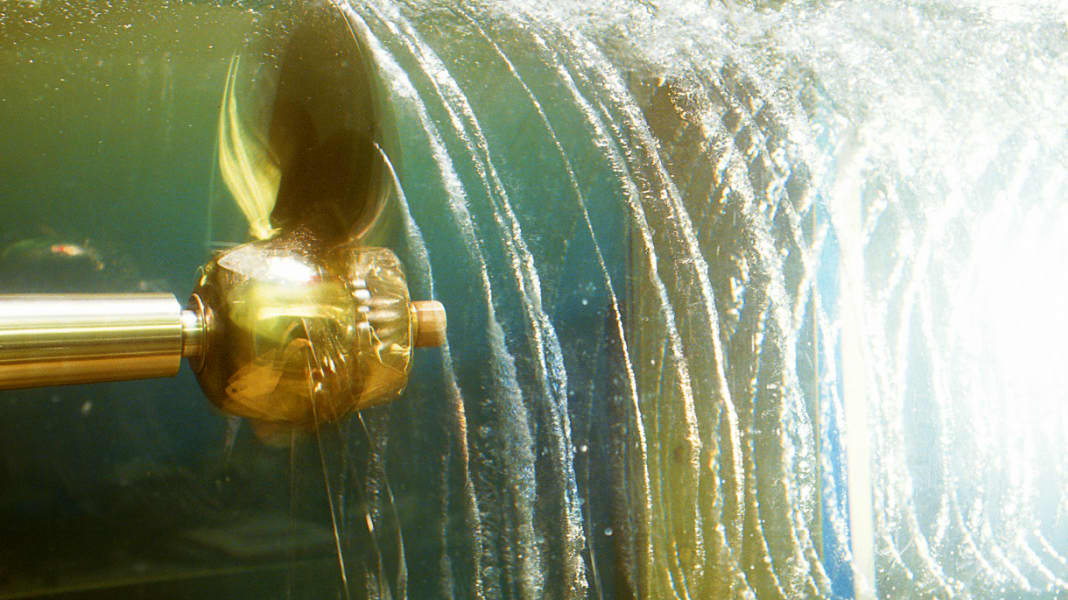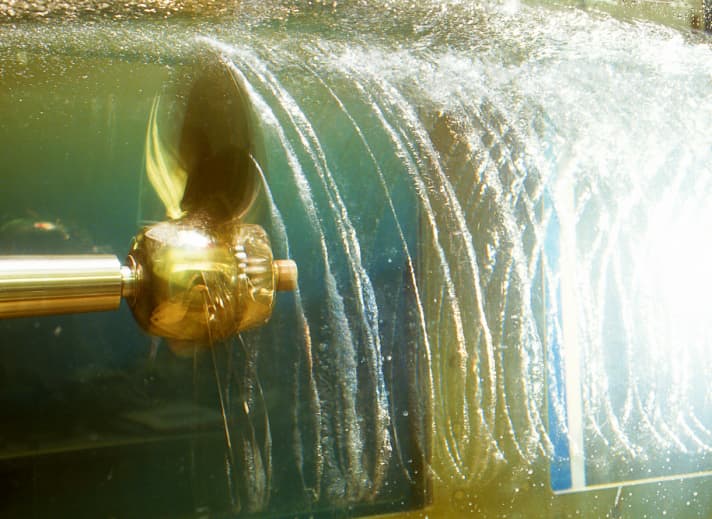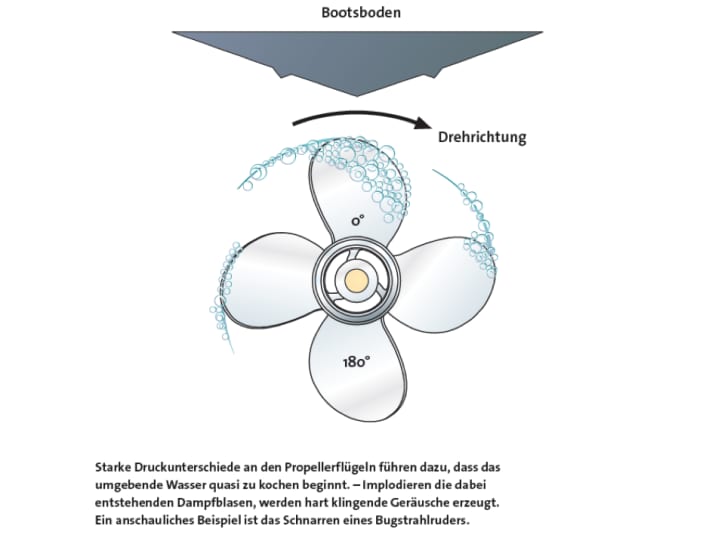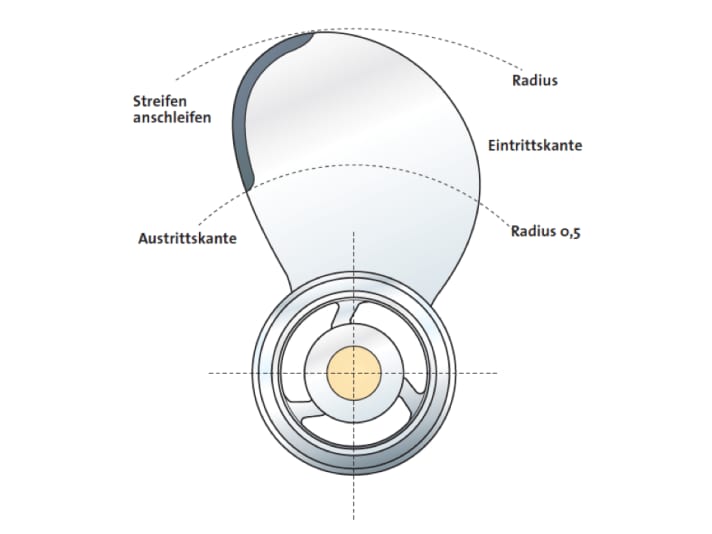

There is hardly a topic that is more complex and difficult to solve than vibration analyses for boats and yachts. The natural vibrations of entire boat areas are often involved and it is almost impossible to decouple them. Even high-quality motor yachts are not spared from vibrations. This applies at least to certain engine and propeller speeds. The frequencies can be transmitted to the hull and are not only a disturbing source of noise, but are also responsible for damage in the long term.
In most cases, the cause is the overall system of the boat drive. However, we will limit ourselves here to the main cause: the propeller. After a brief overview of the vibrations it causes, the causes and elimination of its natural vibrations - the so-called "singing" - will be discussed.
Researching the causes
The vibrations are mainly triggered by non-uniform flow fields in the wake of the boat, which also include inclined shafts and shaft brackets or Z-drives. The resulting torsional and rotational vibrations on the propeller are a much-discussed topic among experts. Other frequent causes are pressure fluctuations triggered by short-term cavitation on the blade.
Finally, the extremely annoying "singing" of the propeller should also be mentioned. These are the natural vibrations of its blades. Especially at higher loads, pressure fluctuations on the propeller blade over the 360° circle of rotation can hardly be prevented - regardless of whether it is a drive with an inclined shaft or a Z-gearbox. In the most unfavourable case, the speed-dependent vibrations are transmitted to the drive and boat hull.
Propellers with an uneven number of blades and with strongly cambered blade contours reduce the risk potential. Although their propeller efficiencies are somewhat poorer, propellers with five or even seven blades can reduce the risk of pressure fluctuations for small and large motor yachts. In large ships, propellers with a much higher number of blades are used to limit vibrations.

Bubble cavitation on the propeller blade
Another cause of propeller oscillations are special cavitation properties - and here in particular the so-called "bubble cavitation" - which can occur periodically on the blade depending on the pressure curve. The briefly formed vapour bubble collapses again on the blade with great force as the negative pressure decreases.
Bubble cavitation generates sharp impacts. The noises are aggressive, so that damage to the propeller - and possibly also to the subsequent gearbox - cannot be ruled out under prolonged load. In most cases, propellers with a larger surface area ratio provide a remedy. Unfortunately, it is unavoidable that the propeller efficiency will also deteriorate somewhat in this case.
Natural vibrations of the propeller
But let's turn to the special topic of this article: the propeller's natural vibrations. This problem area includes the characteristic "singing" of the propeller. Even though this phenomenon is relatively rare nowadays and is unlikely to cause any damage to the propeller and drive, the considerable loud frequencies are extremely unpleasant for the crew on board and should definitely be eliminated.
The singing depends on the speed: the higher the propeller speed, the higher the frequencies of the "singing".
the higher the frequencies of the "singing". It reaches a noise level that lies roughly in a frequency range between 400 and 1500 Hz. High-quality propellers made of bronze or stainless steel with thin blade profiles at the blade tips can be affected by this. The causes of the natural vibrations are difficult to determine. Identical propellers on different boats can show completely different reactions.
What makes the wings "sing"?
The phenomenon of "singing" has been known for many years and has been investigated many times. For example, a series of tests with singing propellers were carried out in Wageningen (Netherlands) back in the 1950s. The excitation pulses are usually triggered by the wake field of the boat.
It is assumed that the separation of the flow at the blade trailing edges occurs periodically from the pressure and suction side. The resulting alternating forces on the wing cause vibrations and are responsible for the unpleasant "singing" of the propeller. It is a similar effect that causes our flag to flutter instead of pointing straight into the wind.
Although the connection has not yet been clearly proven, it cannot be ruled out that propeller singing can also be triggered by unsteady cavitation. This applies in particular to propellers with complete blade profiles and a small area ratio.

How can the "singing" be eliminated?
A simple measure that is difficult to implement on an existing boat, however, is a slightly different arrangement of the propeller downstream of the boat, the shafts, shaft brackets, rudder or Z-gear. A slight increase in the distance is often sufficient to eliminate the excitation pulses.
If this is not possible, do not throw away the existing propeller straight away, as even a minor overhaul of the propeller blades can help. - However, this should be carried out professionally. We recommend sanding a narrow strip on the pressure side in the area of the profile exit edge.
The width of the strip, which should only be slightly tapered, should be a maximum of 10 mm and extend from half the wing radius to the wing tip. This applies to a propeller diameter of about 0.40 m and a medium wing area ratio. As the propeller size increases, the strip to be machined may become slightly wider. Finally, the trailing edge is slightly rounded again and the wing surface is polished.
Summarised once again
Although the propeller is the ideal thrust generator, at least up to around 40 knots, vibrations are still a much-discussed topic today. And this despite decades of further development of special propeller types for different requirements and speed ranges. The selection of optimum propeller data for a particular boat alone requires extensive experience in theory and practice.
Non-uniform wake fields are a constant source of inspiration for new ship designs. For example, even sterns and rudders are currently designed asymmetrically in order to ensure a uniform wake field in the propeller inflow.
To reduce vibrations, propellers with a large number of strongly sickled blades have also become established in recent years. Nevertheless, who hasn't experienced plates dancing on the table (and not just during a stop manoeuvre)?
The "singing" of the propeller, caused by natural vibrations of the blades, can nowadays almost always be eliminated by taking appropriate measures. As the unpleasant frequencies of this "music" are hardly acceptable for the crew on board, boat owners should not hesitate to commission specialised companies to eliminate them.

